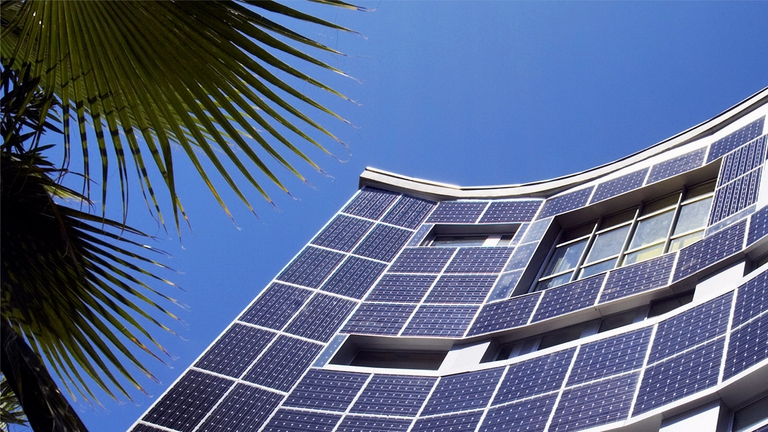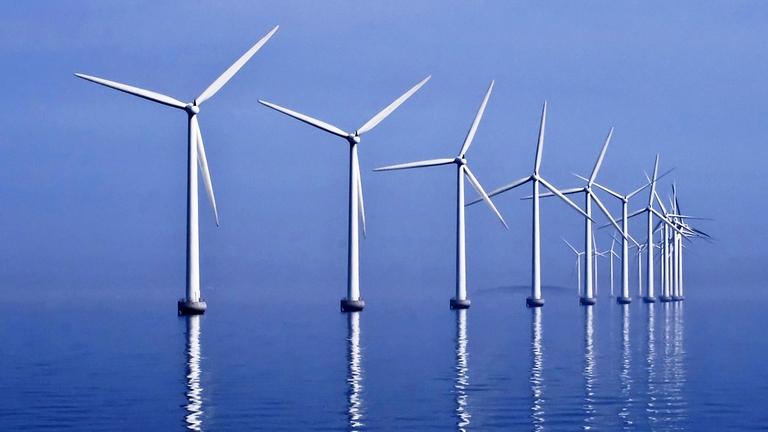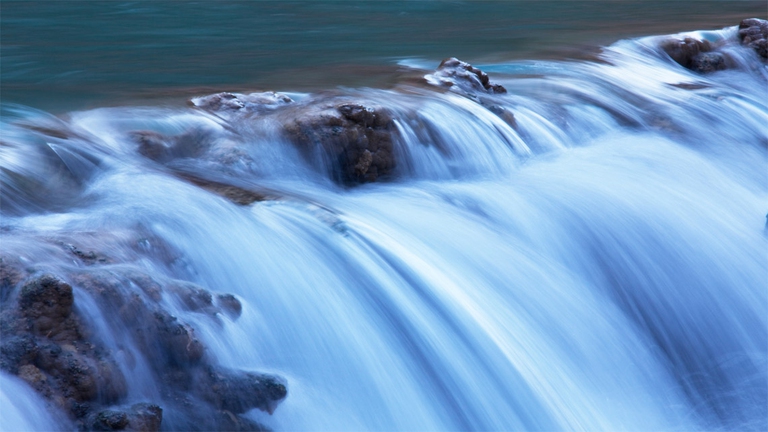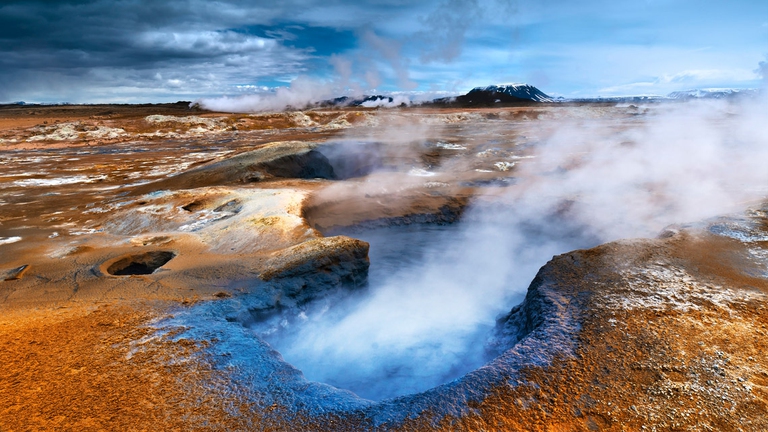https://www.lifegate.it/energie-rinnovabili
- |
The enormous reserves of natural fuels formed during the evolution of our planet, sedimented in the depths of the earth's crust and preserved there for millions of years, we are burning them all in a century.
Oil, coal and methane gas today cover 80% of the world's energy needs;another approximately 6% is covered by fissile material (essentially uranium 235, obtained from natural uranium) in nuclear power plants.Which means that nine tenths of global energy needs are still covered by dirty, old, exhaustible sources and that only the remaining portion already comes from renewable energy sources (hydroelectric around 6%, biomass, geothermal and wind together cover 5 % about).The Key World Energy Statistics annually released by Iea – International Energy Association – returns the terms of a question that needs to be considered with a certain urgency.The fossil sources they are destined to run out.This will happen in a relatively short time, on a historical scale, to make room for renewable energy.
How much longer will fossil fuels last before giving way to renewable energy
For example, at current rates the coal it could last for another century.Maybe the methane for two.It is currently expected that peak production of petrolium will arrive in a time frame ranging from 5 years to 30 years, if it has not already been surpassed, after which its price will begin to rise until it becomes economically unsustainable.For lower quality charcoal and leftovers bituminous there are supply times in the order of one or two centuries but with greater problems of energy efficiency and polluting emissions into the atmosphere which are already scandalously problematic today.
In the world, the energy demand is growing continuously.At the same time, the need to reduce CO2, fight the greenhouse effect and reduce emissions into the atmosphere of substances that are harmful to health and the environment and that alter the climate is also growing.Two needs that seem difficult to reconcile.
A possible solution is the production of electricity from renewable sources.
Fossil energy sources vs. Renewable energy sources
| Fossil energy sources (oil, coal, tar, gas) |
Energy sources renewable |
| • Limited (the resources present in the world are running out) |
• Unlimited (sun, water, wind, geothermal are renewable and unlimited) |
| • They cause air pollution and CO2 and greenhouse gas emissions |
• They do not pollute, they do not emit carbon dioxide carbon / greenhouse gas |
| • Located in only a few countries (geopolitical tensions and conflicts) |
• They are everywhere:the sun shines everywhere the world |
| • Risks during transport (oil tankers, pipelines…) |
• No transport risk |
| • I am the past | • They are the future |
What are renewable energies and why are they important?
“The era of fossil fuels is over.An energy regime is being born capable of channeling civilization towards a radically new path” says Jeremy Rifkin, President of the Foundation on Economic Trends in Washington and professor at the Wharton School.
Is called renewable energy electricity produced with all sources alternatives to traditional fossil fuels (oil, fuel oil, coal).
The meaning of renewable sources
The sources are called renewable because they are renewed, they have the inherent characteristic of renewing themselves, that is, of not running out due to their transformation on our part into usable energy.Upon closer inspection, the term "alternative energies" is unfair, given that throughout history it has always been the energy of the wind that pushes ships, the energy of water that turns the mills, the energy of the sun that puts motion clouds, rains and winds, and the Earth to grow plants and trees for our nourishment and to build houses and shelters, to give us food and firewood.
Renewables are widespread, scattered energy sources, inherent in the strength of the elements, in the water of rivers and oceans, in the wind and in the sun.Subsoil heat, agricultural crops, underwater currents and high-altitude winds and sea waves are also sources of energy.They are inexhaustible, as well as requiring electricity generation processes with low environmental impact and producing minimal or no CO2 emissions.
The development of plants from renewable sources it would allow us to reduce dependence on oil-producing countries, to stop generating waste that is dangerous or difficult to dispose of, and to forget about oil accidents, disasters at sea, breakages of platforms, pipelines and pipelines.The widespread presence of renewable sources allows us to think of a distributed generation network, which in turn allows us to reduce the costs of energy transport, to maintain the richness of local production, and to avoid exporting capital to distant countries, in Middle East or, worse, in countries that host international terrorist movements.
According to IEA forecasts, renewables will supply 13.7% of primary energy in the world by 2030.If governments implement forms of incentives, they will reach 16%.
Renewable energies in a global perspective
As we explore the potential and innovations of individual renewable energy sources, it is crucial to also look at the bigger picture.Globally, we are witnessing unprecedented expansion in the field of renewable energy.One fact that emerges strongly is the substantial growth in the electrical capacity generated by these sources.
By the end of 2023, annual renewable electricity capacity additions are expected to exceed 440 gigawatts (GW), bringing the cumulative global total to approximately 4,500 GW.This remarkable progress underlines the growing global recognition of the importance of renewable energy and its crucial role in shaping a sustainable energy future.
The sun:photovoltaic, concentrated solar, thermal solar

The sun is a G2 star – a little larger than an average star.In its core, every second, 700 million tons of hydrogen are converted into helium with nuclear fusion reactions, releasing energy equal to 386 billion billion megaWatts.
In 2023, photovoltaics has taken on an even more central role in the renewable energy landscape.Two-thirds of the overall growth in renewable energy this year is attributed to photovoltaics.This impressive development is the result of a combination of factors:the reduction in the costs of photovoltaic modules, which has made this technology more accessible, and the increase in the diffusion of distributed systems, which have expanded the use of photovoltaics in different geographical contexts.These developments have been supported by policies and incentives in major markets, which have strengthened the attractiveness and feasibility of photovoltaics as a key energy solution.According to theInternational Energy Agency, this trend is evident in the significant increase in photovoltaic installations globally.
Could the sun fully respond to humanity's energy needs?“Of course – replied Hermann Scheer, the architect of German energy policy on LifeGate Radio – the sun projects onto the earth every day 15 thousand times as much energy as we produce with nuclear power and other non-renewable sources”.
The surface of the Earth is reached by 170,000 TW (1 TeraWatt = 1 million million Watts) of solar energy.
Of these 170,000 TW:
– 50,000 TW are reflected from the upper layers of the atmosphere;
– 30,000 TW are absorbed by the atmosphere;
– 90,000 TW reach the Earth's surface.Of these 90,000 TW, most are reflected from the surface or absorbed and re-emitted.A portion instead is transformed:
– 400 TW raise the sea water up to the clouds,
– 370 TW sets the wind in motion,
– 80 TW are transformed by plant photosynthesis.
In short, an immense flow of energy envelops the Earth, modifies and transforms.Collecting this source of renewable energy is the challenge, learning to intercept at least part of this golden cascade.
From solar radiation to electricity
Today there are at least four systems for doing this.
- photovoltaic, in which solar radiation is transformed directly into electrical energy using "silicon solar cells".
- solar thermal, to heat a liquid either directly (the water heating panels widespread in Mediterranean countries) or with a heat pump;
- concentrated solar, thermoelectric-dynamic, with mirrors that concentrate the heat on boilers that vaporize the water, sending it to the turbogenerator;
- passive solar, in architecture, with the rationalization of the shapes, structure, materials and orientations of buildings to capture and retain the greatest amount of sunlight and heat, or regulate heat and cold.
New concentrated solar power plants are on the way, more efficient, versatile and colorful photovoltaic cells, transparent photovoltaic solar modules to be incorporated into the windows and glass of buildings.
The potential of photovoltaics for global energy production
According to the Trans-Mediterranean Renewable Energy Cooperation, 4% of the Sahara's surface covered with photovoltaic panels would meet the energy consumption of the entire globe.
The wind:wind energy and offshore wind

We have 5.2 million billion tons of it above and all around each of us.It's air.An unimaginable quantity of air that continually moves, circulates, heats up and cools down in a perpetual dynamic exchange relationship with the oceans and emerged lands.
The wind is just that.It is the motion of atmospheric masses that swirl incessantly at a planetary level between differences in level (the "gradient"), from high pressure fields to low pressure ones.
The tool for transforming the "power in the wind" into electrical energy (whose factors are the density of the air, the area intercepted by the wind, the instantaneous speed of the wind) is the wind turbine:the wind turbine.There are small ones, from half a meter in diameter (which can generate 20W, like the Marlec 500) and large ones, up to gigantic ones (a Vestas model that releases 1650 kW has a rotor of 120 meters in diameter, as well as a model from the German Repower).
THE progress in the design of wind turbines of the last twenty years allow them to operate even at lower wind speeds, harnessing a greater quantity of energy and collecting it at greater heights, increasing the quantity of exploitable wind energy and reducing rotation speed, noise and landscape impact. .Many territories could be used to generate wind energy in sparsely populated areas, windy regions such as the great plains of North America, northwest China, Eastern Siberia and the Argentine regions of Patagonia, in addition to the enormous potential of offshore plants.One of the world's leading environmental scientists, Lester Brown, is convinced that the next energy future is his:“wind is abundant, cheap, inexhaustible, widely distributed, does not damage the climate and is clean”.
The wind, from renewable sources to electricity
The very different types of wind farms correspond to the needs of adaptation to the territory:
- Onshore wind farms, with rows of turbines on land and slightly elevated ridges
- off-shore wind farms, to which attention has shifted because the wind at sea is more intense and less turbulent than on land, with advantageous effects both on the energy produced, which is the most important aspect, and on the life of the turbines ... And future prospects predict in the coming years installations resting on the seabed up to a few hundred meters deep (today it reaches a few tens of metres) and, subsequently, wind farms on platforms anchored to the seabed
- mini-turbines, architecturally integrated into buildings or port structures (on which great architects from Dubai to London, from Philippe Starck to Renzo Piano, have worked).
The potential of wind power for global energy production
According to experts at the World Watch Institute, systematically and strategically exploited onshore winds alone could already provide energy equal to four times global energy needs.
That is, the wind, alone, can give the world all the energy we consume today, and there would be three times as much leftover.Not to mention the offshore winds, which are even stronger, more stable and promising.
In a study to quantify global wind energy resources called Wind Force 12, the European Wind Energy Association concludes that the global potential for energy that can be generated from wind would be double the global electricity demand forecast for 2020.
The water:hydroelectric and mini-hydro

Water covers 71% of the Earth's surface and occupies an enormous volume, impossible even to imagine.One and a half billion cubic kilometers.
All the waters of the planet, of the oceans, of the rivers, of the subsoil and of the atmosphere, are connected to each other.Everywhere the waters circulate and are renewed over time.The average times of this flow are really different.A single molecule of water remains in the deepest underground aquifers for millennia on average;in the oceans it lasts for hundreds of years;in the atmosphere does not exceed 4 days.
The complex dynamics that connects all 1,400 billion cubic kilometers of water on the planet is called hydrogeological cycle.
It's called instead hydrological cycle the dynamics of the waters circulating in the atmosphere alone - approximately 577,000 km3, no more than 0.000041% of the total hydrosphere But sufficient to cover the entire globe, to determine the meteorological conditions, the climate and life on Earth.
The atmospheric waters are totally renewed every year 40 times.
From a macroscopic view, it is this enveloping, restless, powerful push - triggered by solar radiation which prevents water from remaining stagnant - which is channeled into rivers, streams, rains, evaporations, that must be harnessed for its transformation into energy.It is the perpetual movement of water that transforms.
A summary indication of its potential in the world can be seen from the surface water map, i.e. from the masses of water in circulation and in motion due to annual precipitation.
– North America:18,300 km3
– South America:28,400 km3
– Europe:8,290 km3
– Africa:22,300 km3
– Asia:32,200 km3
– Australia:7,080 km3
Each continent has thousands of cubic kilometers of moving water, only in the form of rainfall.Of these, the run off (i.e. the water that remains, which does not return to circulation through evaporation) varies from 45% in North America and Asia to 20% in Africa (where the evaporation rate is the highest).
Water, from renewable sources to hydroelectric energy
A hydroelectric plant is defined as the engineering-construction system consisting of the complex of hydraulic works, machinery and equipment with which the potential energy of water is transformed into electrical energy.
Hydroelectric power plants can be of two types:flowing water, when they directly exploit the flow of a watercourse;or accumulation, when they exploit a collection basin upstream of the power plant which allows the desired water flow to be channeled.
From a dossier presented by the Istituto Ambiente Italia it appears that there are 50,000 large dams in the world (those more than 15 meters high), 67% of which are concentrated in China, Turkey, Iran and Japan.Due to these dams, between 40 and 80 million people have been forced into forced exodus, over 35 million in India alone.Practically a nation larger than Italy was evacuated and destroyed;indeed, submerged.The solution for obtaining hydroelectric energy is not that of large dams, but the construction of "mini-hydro", small turbines placed on the edges of rivers that remain free to flow.
The potential of water for global energy production
Dams and river diversions are very problematic and sometimes unacceptable operations today from a social and environmental point of view.But water can also mean energy from waves, tides, underwater currents.Various systems are being studied - bridges suspended on the shore that sway, metal columns inserted into the sea like gigantic barometers, pumps, buoys, basins, parabolic slides to intensify the jets of water - to exploit the wave motion which, being continuous and restless movement, it is believed to generate usable energy.Then there are enormous masses of water that move at constant speed under the sea:the Strait of Messina, the Strait of Bonifacio, the Strait of Gibraltar... The Norwegians and the English have conducted some experiments, simply sinking wind turbines modified to resist corrosion into the water, but an aeronautical-derived blade is certainly not suitable for the purpose:naval propellers are significantly different from aerial ones.Here we are dealing with enormous flows of water that flow at low speed;the exact opposite of wind power, where the fluid (air) has low density and high speed.And, for the tides, in northern France, in Brittany, on the estuary of the Rance river near Saint Malò, a large tidal power plant was built, inaugurated in 1966.The first in the world.In this location the high difference in height reached by the tides allows the fall - of a few meters - of large masses of water, thus allowing the kinetic energy of the tides to be transformed into electrical energy.
The land:geothermal

If we could drill a well 6,400 km deep towards the center of the Earth, we would find a core of iron and nickel of about 6,000°C.Here it is, the heat of the thermal waters and geysers.The term geothermal derives from the Greek “gê” and “thermòs”:the literal meaning is therefore heat of the Earth.Geothermal energy means that contained, in the form of "heat", within the earth.
The origin of this heat is related to the intimate and hidden nature of our planet and the physical processes that take place there.A heat present in enormous, incalculable, inexhaustible quantities.
Internal heat propagates regularly towards the surface of the earth, which emanates heat into space that can be quantified in an average thermal current of 0.065 Watts per square meter.The thermal gradient, i.e. this progressive temperature scalar, is on average 3°C every 100 m of depth, i.e. 30°C every km.If you drill for a kilometre, it is 30°C warmer down there.
From its deepest layers a slow, continuous heat rises to the surface.Its fertile surface layer feeds agricultural crops whose use for energy purposes has today become a challenge, at times problematic.
The Earth is covered in forests, it gives birth to plants that feed us and give us materials to build.It gives us warmth.A vital environment that has been producing and reproducing, for millions of years, plants, trees and life.But only a much more careful, rational, intelligent, "distilled" use of these resources can ensure a sustainable future.
Geothermal power plants transform this heat into electricity in various ways, which can be summarized in the process of pushing steam towards generating turbines.
The heat of the Earth:from renewable sources to domestic heating
Today there are many geothermal plants of significant dimensions in 22 countries around the world - for a total power of almost 10,000 MW, with an electricity production of over 50 TWh.In leading positions are the USA, New Zealand, Italy, Iceland, Mexico, the Philippines, Indonesia and Japan.
For use aimed at producing electricity, the potential is estimated to be 10 times higher than the current one.
However, geothermal energy brings with it the need for engineeringly complex and high-impact systems.Here too, the solution seems to be in the word mini.Heat pump and district heating technology could bring hot water and domestic warmth to homes in many countries around the world, avoiding the need for boilers, heating and air conditioning systems.The energy potential of hot water for thermal uses is very large and widespread in Europe, Asia, Central and South America.That is, apart from the production of electricity, depending on the temperature of the geothermal fluid, various uses are possible, greenhouses in agriculture (38 – 80 °C), district heating (80 – 100 °C), industrial uses (at least 150 °C), thermal.
Is there geothermal energy only where geysers or boraciferous fields blow?No.The earth's temperature increases with depth regardless of location.It's about having a system to bring this heat to the surface.The heat accumulated in the ground can be "brought up" with a heat pump, inside the houses, as heating.
Multiple residential units can be connected to a heat pump.The more buildings are connected to the same system, the more the costs of the pump are divided (the size of which must be chosen based on the number of people who use it) and the more you save, in the "land-water" case, on drilling costs for the probe that is sent underground to 30/50 meters, where there are constant temperatures.
Looking to the future:renewable energy in Europe and Italy
In the European context, we see a significant increase in dependence on renewable energy.Europe, through initiatives such as the REPowerEU plan, is taking decisive steps to reduce its dependence on natural gas and other fossil fuels.The REPowerEU plan represents a key element in this strategy, aiming to replace a significant part of annual gas consumption with renewable energy.This paradigm shift not only underlines Europe's commitment to sustainability, but also highlights the vital role of renewable energy in the continent's energy security.
In Italy, the government is actively encouraging this energy transition.Various decrees and incentives have been introduced to promote the use of renewable energy, including the end of the protected market and incentives for the self-production of renewable energy.A particularly significant initiative is the development of floating wind farms, with the government that identifies maritime state-owned areas suitable for offshore wind infrastructures.However, despite these efforts, Italy still has to catch up with other European countries, particularly when it comes to permitting renewable energy projects.
These developments in Europe and Italy represent an important step towards a more sustainable future.As we face the challenges of climate change and energy security, renewable energy emerges as a key solution, offering a path to a greener and more resilient future.
